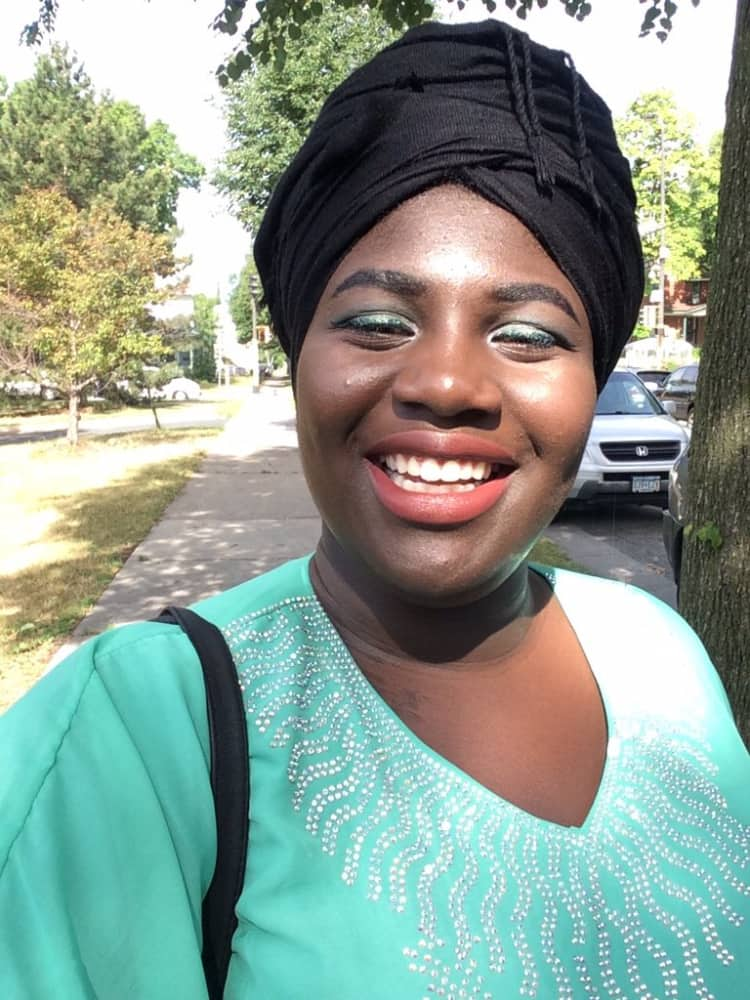5 Black Muslim Women On Why #BlackOutEid Is Important
“It’s one of the few times I don’t have to push myself into a space or feel like I don’t belong.”
Eid al-Fitr, which marks the end of Ramadan, is one of the most important holidays on the Islamic calendar. And in recent years during Eid celebrations, as Twitter and Instagram have become portals into our day-to-day experiences, the hashtag #BlackOutEid has trended across social platforms in response to the erasure of Black Muslims. People began to note how apps like Snapchat, which offered filters to honor the Islamic faith during the holy month, excluded fuller representations of practicing Muslims. #BlackOutEid started not just as a way to showcase the range of Eid dress as a counter to invisibility, but to highlight the diversity of experiences — images of Black Muslims proudly adorned in bright fabrics, traditional dress, and others with their own unique twist, flooded timelines.
Often, it can feel like there is a demand for Black Muslims to segment ourselves into nonexistence. The pervasiveness of black culture in American media, combined with preexisting anti-blackness, has manifested itself in American-Muslim communities through the over-policing of black citizens. Clothing became a distinctive marker of blackness and faced backlash; such as hijabs styled like turbans on Black Muslim women being labeled “haram” by non-Black Muslims, while YouTubers profited off the “turbanista” trend.
Masquerading under a falsely homogenous religious appeal, it’s the old, “We’re all Muslim. Allah doesn’t care about race.” But the world we inhabit does, and there is nothing unholy about pushing back against colorblind narratives and recognizing our realities. During a holiday where we are called on to wear our best, #BlackOutEid became an important space to reclaim expression.
Below, five Black Muslims explain their thoughts on Eid, cultural dress, and black identity. They come from different backgrounds, diasporas, and histories, but share in common a reality that black feminist poet Audre Lorde perfectly captured years ago: “There’s always someone asking you to underline one piece of yourself — whether it’s Black, woman, mother, dyke, teacher, etc. — because that's the piece that they need to key in to. They want to dismiss everything else.”
Isha Camara

Isha, a born and raised Southsider from Minneapolis, is an 18-year-old Black Muslim and poet. She will be attending University of Wisconsin-Madison in the fall.
My parents come from two small West African countries, Gambia and Senegal. Because of how I dress — jeans, crop tops, turban, bright make up — or speak, I’m usually asked if I’m a convert. To others, being black and born into the religion isn’t common. People associate Muslims with fair skin, silky hair, neck covering hijab styles; the kind of women portrayed in media.
Arabs I’ve been in conversation with know what kind of superiority they have. With how they speak and act around me, they don’t consider me the same kind of Muslim they are. Recently, some said, “You must come from a dark country,” referring to my skin and the status of my country.
For Eid, a lot of the outfits come from Gambia. Our mosque is under the Gambian Association, so many of the people come from there and Senegal. The dresses, abayas, and scarves all come from there. My mom makes us wear our best; I’ve never worn an Eid outfit twice. It’s kind of “go big or go home” when it comes to Eid fashion.My culture goes hand in hand with Eid practices. The food is the same, the music, the happiness- it’s all tied together. It’s one of the few times I don’t have to push myself into a space or feel like I don’t belong. I don’t have to forge room for myself. During Eid, I don’t feel different, separate, or like a sub-group of Muslims. No one’s questioning me about where I’m from or why I look the way I do, because I belong here.
Dua
Dua is a Sudanese multidisciplinary performing artist based in Minneapolis. She recently landed the 2017 VERVE Grant, a feature on Button Poetry, and a primary role in an indie web series called Sweetness of Wild.
Eid has always been a simultaneously celebratory and tumultuous day in my household. Every year, I’m awoken to an imam reciting qira’ats through a surround sound stereo. My mother takes special care to wake us, urging us to shower and wear clothes that she’s helped prepare for us weeks prior. Often it is bright flowing attire hiding the shape of my body and a bright, enclosed hijab blending well with the clothing. Sometimes we wear muted colors and dark tones, focusing on modesty and humility as our primary source of inspiration. In the commotion of it all, I've always observed the ways that the family functioned as a unit, mobilizing in unison in an effort to maintain allegiance to the Almighty.
In past years, I've gone the easy route by wearing an extravagantly bedazzled black abaya with a matching scarf. During other times, I conform to a more modern interpretation of Black Muslim-American attire, often inspired by Black Muslim fashionistas in the west. I’ve recently come to realize that most of the clothing that I wear for Eid is merely performative.
My attire isn’t reflective of my personal relationship with the deen, but reflective of the image of a Muslim that I’ve been indoctrinated to believe is socially accepted. This means that I strip myself of any cultural markers that may obstruct the world’s understanding of Islam. This often becomes a way for me to showcase my allegiance to Islam as a social. I become hyper-cognizant of my physical appearance, taking into consideration the ways that I am hyper-sexualized for the color of my skin, the shape of my body, the ways that I express my sexuality, and so on. It's also one of the few times that I feel most inauthentic in expressing my Muslim identity. It feels as though, through the performative nature of my attire, I’m grasping at thin straws to validate my existence.
Mikel Aki’lah
Mikel is a 17 -year-old African-American and Caribbean poet from Brooklyn. Published in the 2012, 2013, and 2014 Poet Linc Youth Anthology created by Lincoln Center for the Performing Arts, she plans to become an English teacher abroad.
I frequently see Black Muslims excluded socially and made to seem like they’re unimportant to the community, because we are not “valid.” We exist separately from other groups and are essentially ignored. I’m viewed as “unfortunate” and “less than,” my identity reduced to unimportance and lacking value, because I am not Arab — it’s almost like committing a crime. Ironically, the same people who think so will use the N-word profusely and ask me about hip-hop songs.
I don’t really identify with a particular community, but in past years people would wear their specific cultural clothing for Eid. Normally, people would be with family or those away from home would go for brunch. However, my family is not Muslim, so Eid looks more like eating and passing out after prayer. I know within some African-American communities, people wear different types of African-inspired clothing as a way to show their roots.
I don’t really bring my culture into Eid. When people hear the word Muslim, a bunch of ethnicities and cultural realities that aren’t mine come to mind. It’s an interesting time, because I don’t have an identity that is seen as “Islamic.” Culture plays a part in a lot of people's experiences and it’s not always a bad thing, but I think people forget Islam is a religion and Muslims are everywhere. My culture isn't seen as conducive to Islamic practices, so it doesn't really play a part. I do try to showcase my personality with how I dress.
Rabiyatu Jalloh
Rabiyatu is a senior at Penn State University. She is also a poet and a international slam team co-champion.
Eid is normally a very hectic holiday for my family. For clothing, my family wears traditional African clothing. The colors are very bright and vibrant. Before I was very aware of my blackness I always wanted to wear abayas, or traditional Arab clothing to the Eid service. I was always under the impression that African clothing was sinful. In my culture, our clothing is very colorful and quick to notice. I always felt like when I wore it I wasn’t observing hijab properly because I was bringing attention to myself.
Dealing with the anti-blackness/ anti-Africanness instilled with me, I make it an effort to wear traditional clothing — what’s usually worn and originated in Mali, called a “bamako” — because my culture is all I have. There are people across the diaspora who’ve been abruptly cut off from the traditions that my ancestors have been practicing for so long. I have the privilege to know that I am a young Fulani woman whose family is from Guinea and Sierra Leone.
Aamina “Amo” Mohamed
Aamina is a podcast host, producer, screenwriter, and organizer based in Minneapolis, Minnesota. Currently she co-hosts a podcast called, Swirl Propaganda, which dissects race, gender, sexuality, religion, and more.
I see Arabization playing out in my community in that “formal” Muslim dress for women is abaya. Somali clothes can’t compare, not even our own Hido iyo dhaqan. I owned an abaya before I owned any form of guntiino (sleeveless one-shoulder dress with traditional Somali pattern). I didn't even know much about them until I grew older. Growing up, Somali culture was saturated with non-Black Muslims, and sometimes non-Muslim, styles for weddings, etc. Our cultural fashions were informal and not seen as anywhere near as beautiful, fancy, and elegant.
Many Somalis still wear abaya and khamiis to Eid prayer. In recent years, you’ve definitely seen a movement for reclamation of culture. I think that might be from the impact of the internet and seeing others asking similar questions. Also, from finding other Black Muslims who are proud of their cultures and of each other's more so than our non-black counterparts.
A few years ago, inspired by a Somali Twitter mutual, I made a baati with a macawiis pattern into a skirt and top. I got flower henna designs with thick petals, noticeably different from thin, intricate Hindi designs. I sent pics to my dad in Europe and he asked why I looked Ethiopian. It was his way of saying I was wearing a variation of cultural dress over “religious”.
On the phone, my mom complains, “Everyone here just wears black. In Somalia, you see the colors, the sparkles.” I ask her, so Eid is different in Somalia? She says Eid here doesn’t compare. Everyone here is always rushing. There, people take their time and you can admire what they’re wearing.
I have conversations with my mom like this a lot. She makes comparisons to back home, in Mogadishu, where the standards of Islamic dress aren’t so shaped or ruled by Arabs. There’s still an influence but you see a difference. You see vibrancy. Here, the standards have been skewed. Many people say we’ve been westernized into “immodesty”; because of that you see cultural dress less. Blackness is, by default, immodest and a form of restriction in what we’re allowed to wear when celebrating Eid.




